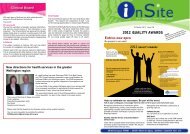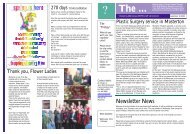Te Arawhata Totika - Wairarapa DHB
Te Arawhata Totika - Wairarapa DHB
Te Arawhata Totika - Wairarapa DHB
Create successful ePaper yourself
Turn your PDF publications into a flip-book with our unique Google optimized e-Paper software.
Takino (1998) stated that ‘whakapapa provides<br />
an organisational framework and literally<br />
translated can mean to activate, to cause, to<br />
bring into being, to create active foundations.’<br />
regardless of the level within an organisation in<br />
which it is being applied whakapapa indicates the<br />
need for a sound infrastructure that has trust, honesty<br />
and openness as features. This can be translated<br />
into a transparency in all aspects of health service<br />
provision, including sound com munica tion channels<br />
and policies and procedures that reflect this value.<br />
Wairua<br />
Documents pertaining to health frequently refer<br />
to wairua and make reference to it being one of<br />
the cornerstones of Mäori health. The meaning<br />
given relates to a spiritual dimension, but often<br />
this value is given a restrictive meaning that<br />
equates only to a Christian philosophy. This<br />
understanding does not describe or define wairua<br />
as a value integral to hauora. kaumätua spoke<br />
of wairua as belonging to the inner self, you are<br />
born with wairua and as you grow so does your<br />
understanding of wairua. This value is nurtured<br />
by your tipuna, kuia, koroua,whänau and hapü.<br />
wairua is influenced by the life and teachings one<br />
experiences. These influence your perception of<br />
wairua and the way in which you perceive and live<br />
your life. wairua, like whakapapa, is interconnected<br />
to all the other values that impinge upon the way<br />
you feel about yourself and others. if you are able to<br />
balance wairua and the other connected values, you<br />
are able to perceive the world in a balanced manner.<br />
<strong>Te</strong> iwi kainga concurred with the views of kaumätua<br />
and believed that wairua was an expression<br />
of one’s inner spiritual self, not restricted by a<br />
Christian description but rather reflected in a Mäori<br />
worldview. it is not possible to think of wairua in<br />
isolation, it has to be regarded as part of a whole.<br />
According to the literature, wairua provides ‘a<br />
centrality to life and living’.(Marsden 1992). Further,<br />
this value allows individuals ‘to be or become’. Like<br />
all other aspects of the Mäori world it has mauri,<br />
providing the elemental energy for growth, making it<br />
central to hauora and positive health outcomes. its<br />
presence allows an individual to balance the inner-self<br />
with the rigors experi enced in the physical world by<br />
providing a spiritual dimension to life, symbolism and<br />
beauty and an explanation of how one perceives the<br />
world and understands both individual and collective<br />
hauora. each living thing has mauri and wairua.<br />
Tohunga were regarded as the keepers of know ledge<br />
and protectors of wairua and mauri. in all areas of<br />
tikanga Mäori the tohunga was your first point of<br />
connection. From the time you were born (in some<br />
cases before you were born if the pregnancy was a<br />
difficult one) the role of the tohunga was absolutely<br />
vital. it was he who recited your whakapapa at the<br />
ritual associated with birth to instil the mauri and<br />
wairua of your ancestors. it was he who recited<br />
the ritual incantations that gave you a name to<br />
carry on the legacy of your ancestors. it was<br />
he who called upon all the necessary elements<br />
(atua) to protect you and guide you through life.<br />
it was also he who laid the path for your journey<br />
to your ancestors when that time came.<br />
The wairarapa is renowned for its whare wananga<br />
or Places of Learning. One such place was called<br />
Matua Pa situated about 300 years ago opposite<br />
the site of the present wairarapa hospital. it was<br />
at this whare wananga that many young Mäori<br />
would travel to learn the skills of the tohunga. Many<br />
of the well known tohunga such as Matorohanga,<br />
Nepia Pohuhu, Tuhoto Ariki and others whose<br />
writings can be found in various manuscripts,<br />
documents, historical records etc, were trained<br />
at whare wananga such as Matua Pa.<br />
Mauri<br />
kaumätua in identifying mauri as a value of hauora<br />
believe that mauri is an integral part of a whole and<br />
without it other values would not be operable. Mauri<br />
is inherent in everything an individual says and<br />
does. <strong>Te</strong> Oranga O <strong>Te</strong> iwi kainga expressed Mauri<br />
as integral to hauora. Mauri is within and around<br />
us and binds us to the other identified values.<br />
Mauri is a life force that is derived from a common<br />
centre and all living and inanimate things encompass<br />
mauri. Like whakapapa, everyone and everything<br />
has a Mauri that permits it to exist in the physical<br />
world yet retain the elements that set individuals<br />
apart or translates them into unique individuals.<br />
Mauri and ora are interwoven; one cannot exist<br />
without the other. Mäori oral history clearly illustrates<br />
this through the ancient exclamation ‘Tihei Mauriora’<br />
(i sneeze, ah i live) said to have been the very<br />
first sound made when human life was created.<br />
Our tipuna believed that any form of physical, spiritual<br />
or mental sickness that afflicted a person was caused<br />
by unseen forces attacking that person’s Mauri. Many<br />
forms of protection were developed to ensure that<br />
a person’s mauri was strong and able to withstand<br />
attacks of any kind. These protection methods<br />
included rongoa Mäori, incantations and rituals.<br />
Sometimes the mauri and ora of a person were<br />
connected to a geographical feature of that area,<br />
hence the strong affinity Mäori have with pepeha<br />
as a form of introduction. The wanganui people<br />
<strong>Te</strong> <strong>Arawhata</strong> Tötika Cultural Competency Framework<br />
19







